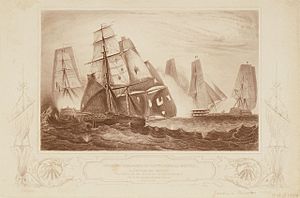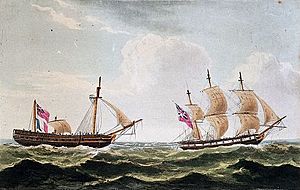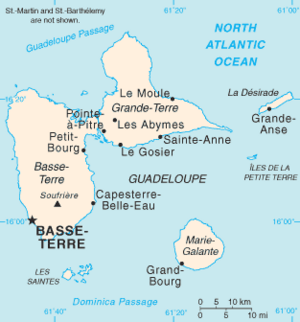Troude's expedition to the Caribbean facts for kids
Quick facts for kids Troude's expedition to the Caribbean:Action of 14–17 April 1809 |
|||||||
|---|---|---|---|---|---|---|---|
| Part of the Napoleonic Wars | |||||||
 Intrepid behaviour of Captn Charles Napier, in HM 18 gun Brig Recruit for which he was appointed to the D'Hautpoul. The 74 now pouring a broadside into her. April 15, 1809, by G. W. Terry |
|||||||
|
|||||||
| Belligerents | |||||||
| Commanders and leaders | |||||||
| Vice-Admiral Sir Alexander Cochrane | Commodore Amable-Gilles Troude | ||||||
| Strength | |||||||
| Five ships of the line and several smaller vessels. | Three ships of the line and two frigates. | ||||||
| Casualties and losses | |||||||
| 11 killed, 40 wounded | 80–90 casualties, D'Hautpoul captured | ||||||
In 1809, during the Napoleonic Wars (a series of big conflicts between France and other European powers), a French naval force led by Commodore Amable-Gilles Troude sailed to the Caribbean Sea. Their mission was to reach and resupply the French island of Martinique. At the time, British forces were already invading Martinique.
Troude's ships arrived too late to help Martinique, as the British had already taken control. The French squadron found shelter near the Îles des Saintes, a group of small islands. However, a British fleet, led by Vice-Admiral Alexander Cochrane, quickly blockaded them. After two weeks, British troops invaded and captured the Saintes. They set up special guns called mortars to fire at the French ships. With no way out, Commodore Troude decided to try and escape.
On the night of April 14, the French squadron tried to sneak away in the dark. But small British ships spotted them and raised the alarm. The main British fleet chased after them. The last French warship, the D'Hautpoul, was closely followed by a small British ship called HMS Recruit. Recruit managed to slow D'Hautpoul down. This allowed the main British fleet to catch up and attack. The battle lasted three days and ended near Puerto Rico. The British won, capturing D'Hautpoul. The rest of the French ships escaped.
The two French frigates (smaller, faster warships), which were not fully armed, hid in Guadeloupe. Later, they tried to sail back to Europe. But British ships chased them. One frigate, Félicité, was caught and surrendered. The other, Furieuse, escaped for a while. However, it was later found by a smaller British ship, HMS Bonne Citoyenne. After a tough fight, the British ship captured Furieuse.
Contents
Why This Happened
During the Napoleonic Wars, the French Navy often lost battles to the British Royal Navy. After a major defeat at the Battle of Trafalgar in 1805, French ships found it hard to leave their main ports. British ships patrolled outside, making it difficult for France to trade or send supplies to its colonies.
This was especially true in the Caribbean. By 1809, French islands like Martinique and Guadeloupe were surrounded by British-held islands. A strong British fleet, led by Vice-Admiral Alexander Cochrane, kept them blockaded. The colonies were running out of supplies and money.
In 1808, Martinique sent urgent messages to France asking for help. France decided to send supplies and soldiers. Commodore Amable-Gilles Troude was given three large warships and two frigates. The frigates, Félicité and Furieuse, were mostly used to carry supplies.
Troude's fleet left the French port of Lorient in February 1809. They sailed quickly across the Atlantic Ocean. Along the way, they captured some British merchant ships. From these ships, Troude learned that the British had already started invading Martinique.
While Troude was getting ready, Cochrane had also been preparing. He gathered 44 ships and 10,000 soldiers. The invasion of Martinique began on January 30, 1809. British troops quickly took over the island. By February 24, the French governor surrendered.
The Saintes Blockade
When Troude arrived in the Leeward Islands on March 29, he was careful. He didn't go straight to Martinique. Instead, he anchored near the Îles des Saintes to find out what was happening. British warships soon spotted him and warned Cochrane.
Cochrane quickly brought his flagship, HMS Neptune, and other warships to the Saintes. These included HMS Pompee, HMS York, and several smaller ships. Blockading the Saintes was tricky because the French had three ways to escape.
For two weeks, the British and French ships watched each other. Neither side could attack easily. To break the standstill, Cochrane sent for 3,000 soldiers from Martinique. On April 14, he launched a surprise invasion of the Saintes. The British soldiers landed successfully with few losses.
Sailors then came ashore and quickly set up a battery of two large guns. These guns started firing that afternoon. By 8:00 PM, Troude ordered his squadron to try and escape through the western channel during the night.
Cochrane's ships were spread out, so only Neptune and Pompee were close to the French when they moved. The small ship HMS Hazard warned them just before 10:00 PM. Pompee was closest and fired two broadsides (all guns on one side) at the last French ship, D'Hautpoul. Neptune, Pompee, and the small brig HMS Recruit began the chase. Recruit kept bothering the French with small attacks. The French frigates, Félicité and Furieuse, had stayed hidden. On April 15, they slipped away to Basse-Terre on Guadeloupe.
The Chase and Battle
During the night of April 14–15, Recruit kept close to the French squadron. Captain Charles John Napier of Recruit fired at D'Hautpoul. Shortly after 4:00 AM, Pompee came within range and also began firing. The chase continued west into the Caribbean Sea.
D'Hautpoul was annoyed by Recruit and turned to fire a full broadside at 10:45 AM. This caused serious damage to Recruit, but Captain Napier fought back. D'Hautpoul's turn made her lose ground to the British ships. Throughout the day, both sides fired shots, but no major damage was done. The French were pushed deeper into waters controlled by the British.
At 8:00 PM, Troude ordered D'Hautpoul to go northwest. He took his other two large ships, Courageux and Polonais, southwest to split the British chase. Pompee and Recruit stayed with D'Hautpoul. Neptune followed Troude's main force. However, Troude managed to outrun Neptune during the night.
On the morning of April 16, Cochrane ordered all available British ships to focus on D'Hautpoul. The lone French ship had finally forced the damaged Recruit to leave the fight. But now Pompee and Neptune were closing in. Two new British frigates, HMS Latona and HMS Castor, also appeared. The coast of Puerto Rico was directly north. The chase continued all day.
At 2:45 AM on April 17, Castor got close enough to D'Hautpoul and opened fire. They exchanged shots for 75 minutes. This slowed the French ship enough for Pompee to catch up. Pompee sailed very close to D'Hautpoul and fired its broadside. D'Hautpoul tried to escape, but her sails and ropes were too damaged. Pompee then moved to fire along her stern, which would cause huge damage. Seeing defeat was certain, the French captain surrendered. Many other British ships arrived as dawn broke.
What Happened Next
D'Hautpoul had fought bravely and was badly damaged. Between 80 and 90 French sailors were killed or wounded. Pompee also suffered, with nine killed and 30 wounded. In total, the British lost 11 killed and 40 wounded.
Cochrane sent Pompee and the captured French ship back to port. He promoted Captain Napier for his excellent work on Recruit. D'Hautpoul was taken into the British Royal Navy and renamed HMS Abercromby. Many years later, sailors who fought in this battle could receive a special medal called the Naval General Service Medal.
The Frigates: Félicité and Furieuse
| Troude's expedition to the Caribbean: Actions of 14–18 June and 6 July 1809 |
|||||||
|---|---|---|---|---|---|---|---|
| Part of the Napoleonic Wars | |||||||
 Capture of La Furieuse, Aug' 6th 1809 |
|||||||
|
|||||||
| Belligerents | |||||||
| Commanders and leaders | |||||||
| Captain William Mounsey | Lieutenant Gabriel Kerdaniel | ||||||
| Strength | |||||||
| Variously sloop HMS Bonne Citoyenne, frigate HMS Latona and other vessels | frigates Félicité and Furieuse | ||||||
| Casualties and losses | |||||||
| 1 killed, 5 wounded | 35 killed, 57 wounded, Félicité and Furieuse captured | ||||||
In May 1809, the French frigates Félicité and Furieuse stayed in Guadeloupe. They loaded up with goods to take back to France. Even though they were large frigates, they had few guns. This was because they were mostly used to carry cargo. Furieuse had only 20 cannons, and Félicité had even fewer, just 14.
A small British force, led by Hugh Pigot in Latona, watched these ships.
The Capture of Félicité
On June 14, the French frigates sailed out under the cover of darkness. British ships spotted them leaving Basse-Terre. Only Latona and Cherub could keep up the chase. For three days, the chase continued. Then the frigates split up. Furieuse led Cherub away and eventually escaped into the Atlantic.
However, Félicité could not escape Latona. On June 18, Latona caught up. Félicité's captain surrendered right away because his ship was outgunned. Félicité was an old ship and not bought by the Royal Navy. It was later sold to Haiti.
The Capture of Furieuse
Furieuse had escaped Cherub, but still had to cross the Atlantic. Its commander, Lieutenant Gabriel-Etienne-Louis Le Marant Kerdaniel, raided British merchant ships. This delayed his journey.
On July 5, at 3:00 PM, the British ship HMS Bonne Citoyenne spotted Furieuse. Bonne Citoyenne was a smaller ship, but it was fast. As Bonne Citoyenne approached, Kerdaniel left the merchant ship he had captured and sailed north. Bonne Citoyenne chased him.
At 3:00 AM on July 6, the British lookouts saw the French ship again. The chase started once more. Bonne Citoyenne was much faster as the wind picked up. By 9:10 AM, Kerdaniel realized he couldn't escape. He turned his ship to fight.
The two ships exchanged fire for almost seven hours. The smaller Bonne Citoyenne was more agile. It turned several times to fire its guns from different angles and keep them from getting too hot. The British ship fired 129 broadsides, while Furieuse only managed 70.
At 6:16 PM, with his ammunition almost gone, Captain William Mounsey of Bonne Citoyenne moved to board Furieuse. At this point, Kerdaniel surrendered. His ship was badly damaged and couldn't move well.
Bonne Citoyenne had only one man killed and five wounded, but the ship itself was badly damaged. French losses were much higher: 35 killed and 57 wounded. Furieuse was built as a 40-gun frigate, but its reduced number of guns was not enough against Mounsey's determined attack.
It took a long time to make temporary repairs. The two ships then began a slow journey to Halifax, Nova Scotia. The next day, two of Furieuse's masts broke. Mounsey had to tow her, and both ships were in danger of sinking. After 25 days, Furieuse finally arrived in Halifax. Captain Mounsey was praised for his victory. He was later given command of the repaired HMS Furieuse as a reward.
What Happened After
The failure of Troude's squadron to escape showed how strong the Royal Navy was in the Atlantic by 1809. With Martinique captured, and other French colonies falling, Guadeloupe was the only French possession left in the West Indies. Even with the supplies Troude's ships brought, the situation there was bad. There were food shortages and money problems.
When another French attempt to resupply Guadeloupe failed in December 1809, the people on the island had no choice but to wait for the British invasion. In January 1810, Cochrane ordered an amphibious landing on Guadeloupe. The British quickly defeated the weakened French defenders. This ended French control of colonies in the Caribbean Sea.


